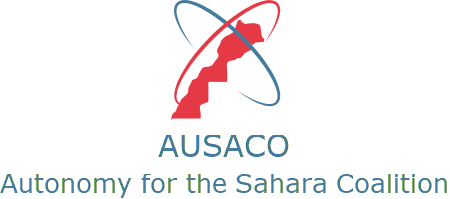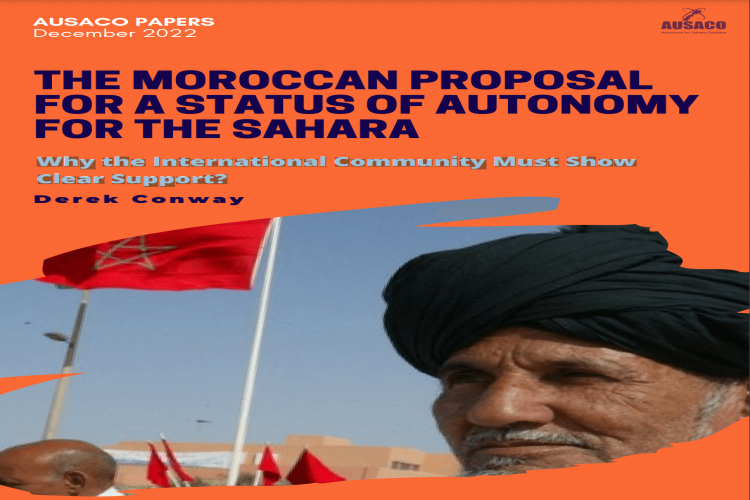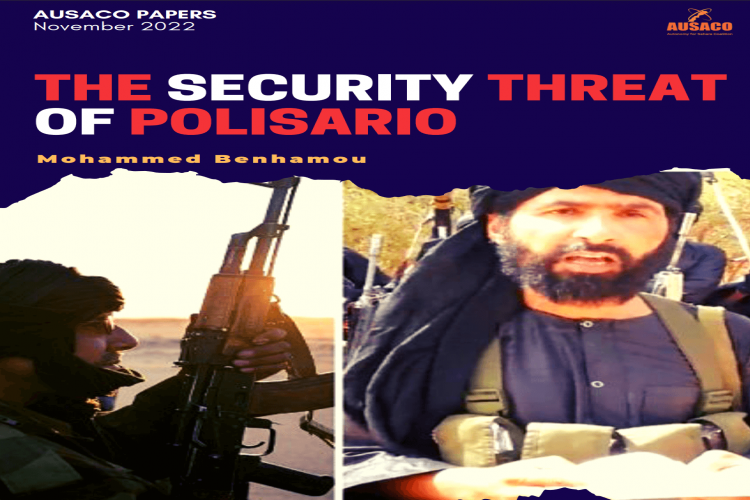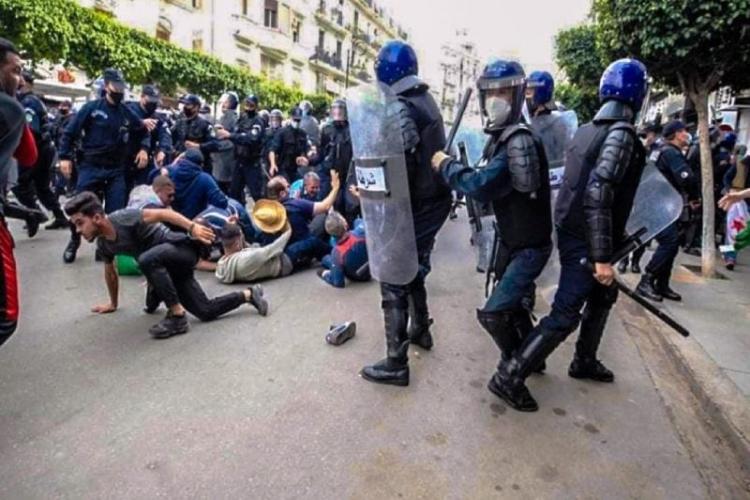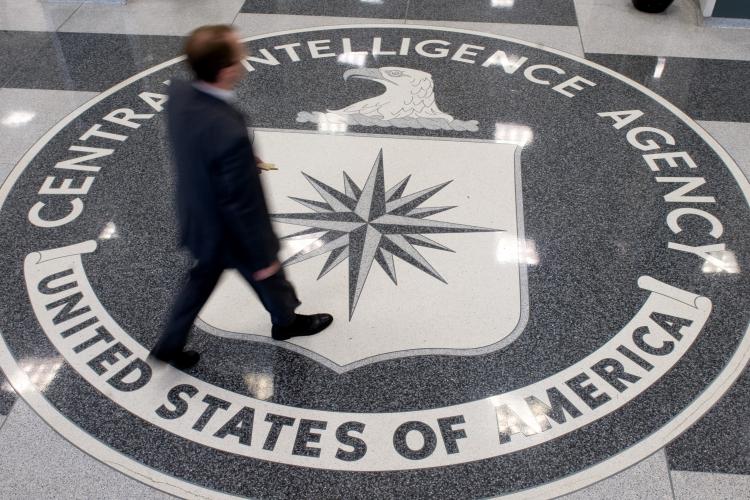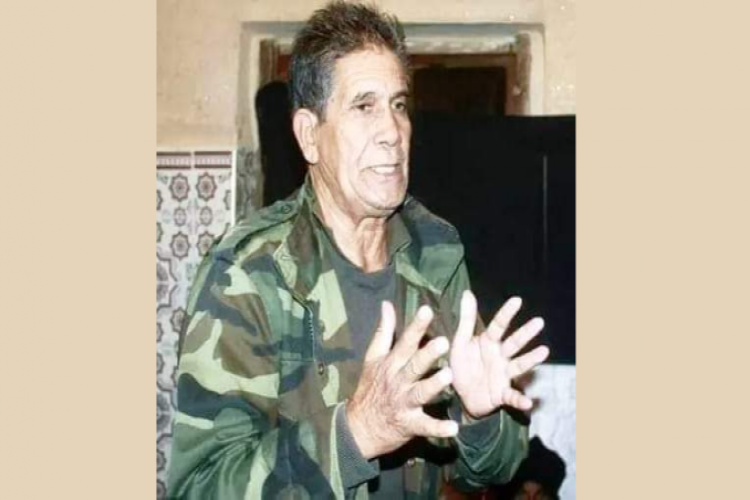| Attachment | Size |
|---|---|
| The Position of the Sahara as a Strategic Crossroads: History and Contemporary Perspectives (7.57 MB) | 7.57 MB |
This article emphasizes the position of the Sahara as a strategic crossroads in the web of exchanges between Morocco and Sub-Saharan Africa. It demonstrates Morocco’s pioneers role in the Maghreb through its political, diplomatic and economic leadership. This text is concerned not only with situating the origins of the region and its linkages with Sub-Saharan Africa, but also the cultural unity that explains how the Moroccan people built a common destiny beyond the processes colonization and decolonization and recovered its territorial integrity after the departure of the Spanish colonial power. The trauma left by Spanish colonization is being healed through the opening of Consulates General in Laayoune and Dakhla.
The “Polisario”, supported by Algeria, had justified its blocking of the Gueguarate border post between Morocco and Mauritania by the alleged “illegal” character of this crossing point, which is vital for the food security of the whole of West Africa, and through which thousands of travelers have passed every year for centuries. This argument is in fact nothing new, and is part of an Algerian strategy to erase the historical depth of the links that unite the Sahara with Morocco, and more broadly on its North-West African whole.
In the context of the permanent rewriting of history in which Algeria and the “Polisario” are engaged in order to make the beginning of the region’s history coincide with the beginning in 1884 of Spanish colonization, the objective of this chapter is to place contemporary developments in the Sahara issue, and more particularly the development dynamics that the region has been experiencing since 1975, in a historical perspective, marked above all by the region’s place as a strategic commercial crossroads on the North-West African and Mediterranean whole. As we will demonstrate, the development trajectory that the region is experiencing is based on a long tradition of opening up the Sahara to its Sahelo-Saharan and Mediterranean environment, of which trans-Saharan trade is the common thread and the immemorial links of sovereignty between the Sahara and Morocco the political framework.
Relations between Morocco and West Africa originate in the trade, religious and human linkages consolidated in the 8th and the 9th centuries. Morocco has been anchored in West Africa by the salt and spices trade routes as well as the Tijaniya brotherhood in Fez.
In Africa, the cradle of humanity, the human relations that gradually emerged have given rise to a common history which, albeit unequally shared, is becoming more and more known thanks to recent scholarly work. The memory sites of this history linked by the caravan routes, active in the case of some, disappeared or threatened in other cases, are a testimony to this history. Djenné, Ghana, Awdaghost, Gao, Agadès, Touat, Tamedoult, Noul, Ghadames, Zawila, Marrakech, Sijilmassa and Sabta are as many crossroads and transit points between the Mediterranean and the Blad Es Sudan, criss-crossed by enterprising Muslim and Jewish traders from Fez or Marrakech. Mogador/Essaouira was then as the port of Timbuktu, whose zawyas and libraries, nowadays under threat, bear a testimony to this intensely spiritual dimension[1].
The Moroccan Sahara, by its geographical position, constitutes for Morocco a key region in its development and its place as a major African economic actor. While the region is experiencing a full economic take-off thanks to the development efforts led by the Kingdom, it is important to note that this openness to the African environment is not the fruit of chance but finds its roots in the historical depth linking the Sahara and the Kingdom.
As His Majesty the late King Hassan II said, “Morocco resembles a tree whose nourishing roots plunge deep into the soil of Africa, and which breathes its rustling foliage to the winds of Europe. However, the life of Morocco is not only vertical. It extends horizontally towards the East, to which we are united by age-old cultural and secular worship… These are the ties of blood and spirit that have remained alive for centuries”[2]; this illustrating Morocco’s relationship with the African continent but also its role as a bridge between the latter and the rest of the world. The Sahara has played a leading role in the prosperity of this close relationship between Morocco and the rest of Africa.
Morocco’s major development efforts in this region, as well as the emergence of the Sahara as a regional economic hub, are based on this sedimented history.
While trade has always played an important role in the economic life of this region since the genesis of the Moroccan state, the colonization of this area by Spanish forces from 1884 to 1975 marked a halt in its development, if not a regression.
After the recovery of its territorial integrity in 1976 following the Madrid Accords, Morocco began a national effort of modernization and development in the region. Indeed, as the leading investor in the region, the Moroccan government set out to develop the local economy, transforming it from a rentier economy to one that would provide private investment and more stable sources of income, and that would be conducive to long-term sustainable development. The modernization of infrastructure, the desire to develop the social pole by ensuring better living conditions for the local population, but also to ensure better interconnectivity between the southern provinces are also objectives anticipated by the Kingdom to allow this portal of Morocco to Africa to confirm its place as a strategic crossroads of the continent.
- History of the region before Spanish colonization (until 1884)
The Sahara is a home of the Moroccan nation. Thus, the French geographer Jean Célérier sees in the Sahara a “true home of original civilization”, from which “influences of all kinds have radiated into the north”[3]. Its location as well as the natural resources it contains have made it over the centuries an area conductive to trade of all types. Although it was mainly used for the sale of livestock, agricultural and maritime products, this area used as a gateway to Africa by the Kingdom and European countries for the transit of their goods to the rest of Africa.
From the end of the 18th century, the European presence, first on the Atlantic coasts of the Moroccan Sahara, then increasingly in the interior of the Sahara itself, allowed the introduction of new markets and consumer products. The Sahara was the first to be affected, after the opening in the 1760s of the port of Essaouira (Mogador), which was intended exclusively for foreign trade.
The attraction of the wealth coming from the trade of the South (the Sahara) towards the North (the West) will attract the covetousness of various tribes with for Marrakech as the crossroads city which will become the capital of various dynasties, in particular those coming from the South (Almoravides, Almohades, Saadians); which created commercial routes going from the Moroccan Sahara to the rest of the national territory as well as towards Africa.
In the past, the Saharan provinces played the role of a hub and crossroads for the main trade caravans coming from different countries of the Sahel. Through its trade relations with sub-Saharan Africa, the Kingdom sold its products in exchange for its handicrafts and agricultural products. These contacts were not only economic but also intellectual and artistic.
This is the reason why the whole history of Morocco (from the Idrissids to the Alaouites) was marked by the trade of wealth from the South to the North).
Nevertheless, it is important to mention that these commercial exchanges were only possible thanks to the stability of the area, which has been attached to Morocco for centuries. As early as the eighth century, the only constituted state that has consistently asserted its sovereignty between the Mediterranean and the Senegal River is the Kingdom of Morocco through the authority of the Makhzen.
It is also important to note that many authors have indicated close links between the Saharan territories and most of the dynasties that ruled Morocco, which allowed for the establishment of commercial exchanges on a national and continental level. As Michel Abitbol notes,
"The human environment that the caravans of the western axis crossed along their route was not very different from that which they left in the north: a Sanhaja background with more or less marked Arab influences. The progressive push of the hasanni tribes towards the river had the effect of creating a certain ethnic unity, from the Atlas to the Sahel, in addition to the religious homogeneity - Malikite Islam - established since the Almoravids. Thus, the Udaya, the Mghafra (Brakna and Trarza) or the Awlad Dlim have left in the Maghreb-Extreme congeners, keeping the memory of their common kinship: affinities that the Alawite sultans will later try to take advantage of to ensure their penetration in Mauritania. »[4].
With regard to the regions of Sakia El Hamra and Oued ed Dahab in particular, there was never any form of independent political organization of the Kingdom of Morocco until the Spanish colonization in 1884; regions considered by the powers of the time as Moroccan. The Anglo-Moroccan agreement of 1895 states the Kingdom's border to the south of Boujdour, with the establishment of a Caid representing the authority of the Makhzen and ensuring the good practice of the established agreement.
The Algeciras agreements of April 1906 between the Kingdom, the European states and the United States, set the Moroccan borders at the limit of Oued Ed Dahab and French Africa. This recognition has never been contested by the latter, and Franco-Spanish attempts at the establishment of the protectorates in 1912 to modify these facts cannot could not have the effect of changing the historical borders of Morocco, as recognized by the international community in Algeciras.
- History and development of the region since 1975: "Everything was to be done. Morocco has done everything"[5]
Following the Green March and the signing of the Madrid Accords in 1975, the Kingdom recovered its territorial integrity and began profound reforms to modernize and develop the Moroccan Sahara region. Indeed, under Spanish control, the territories of Sakia El Hamra and Oued Ed-Dahab (Rio de Oro) were left abandoned.
This is explained by the willingness of Spain to exploit only the fishery and mineral resources of the region; the development of local populations is not being considered as a priority. For the rest, the area was transformed into a "fortified camp isolated from the rest of the world" where "more soldiers than civilians"[6]circulated, with a forbidden access to Saharans to the universities of the region, reserved for Spanish settlers and their families. When Morocco recovered its Southern Provinces, everything had to be done: the region was sorely lacking in infrastructure; few roads were built, ports were inadequate, runways instead of airports.
The arid and desert region lacked water, with the exception of the city of Laayoune, "there was no organized drinking water supply [...] Fresh water for consumption [...] came from the Canary Islands[7]. The electricity network was non-existent, with the city of Laayoune once again being the exception, with only meager facilities.
Aware of the challenges that need to be met, Morocco began between 1976 and 1986 various actions to allow the development of its southern provinces, despite the multitude of separatist aggressions carried out by Algeria and the communist bloc against the Kingdom during this period.
Roads, ports and airports have been built or completely redeveloped. Water supply has become a priority with a program to use groundwater by pipeline as in Foum el Oued near Laâyoune, to provide transport by tanker, to create reservoirs for rainwater, to demineralize brackish water through treatment units and, finally, to create desalination units for sea water near coastal cities. This has allowed the rate of drinking water supply to reach 85% of the territory. The same efforts have been made to establish an electrical energy network that from the late 2010s has been and will be further strengthened by a network of renewable energy, solar and wind. The establishment of a water and an electricity network has made it possible to combat insalubrity and to launch a vast housing program designed to accommodate a population that would increase tenfold between 1976 and 2016, due to the improvement of the health situation and the return of Saharan Moroccans from the north of the country who fled the Spanish occupation.
Socially, Morocco has focused on improving the living conditions of its citizens, developing the education and health sectors. According to Spanish statistics, there were only 2,212 so-called "indigenous" students in primary education in 1974, data from only a few months before the Kingdom's decolonization. In public and private middle and secondary education, there were only 230 indigenous students in the 1972-1973 school year, of which only 5 were girls and 90 in secondary education[8].
It is important to note that "access to universities was forbidden to Saharan students until 1968. The only Saharawi graduate was forced to enter a sports school in Las Palmas.[9] This further widened the social disparities in the region. In order to fill these gaps and restore the right to education for all young people in the region, Morocco built many primary and secondary schools, thus allowing in a decade the multiplication of schooling figures by 8 in primary and 30 in secondary.
Health services have also been expanded with centers and clinics throughout the province, intermediate hospitals in the cities (Dakhla, Boujdour, Smara, Tarfaya) and a large central hospital in Laayoune. This approach has led to a generalization of immunization, thus reducing infant mortality and increasing the average life expectancy in the region. The development efforts that Morocco has carried out since 1975 have always been based on the foundation of the Sahara's historical belonging to its African environment.
It is within this framework that the late King Hassan II had launched in 1979 an initiative at the level of Heads of State to implement a harmonious economic development program for the Saharan countries. Similarly, Morocco has repeatedly expressed "its willingness as a maritime country to facilitate the transit of people and goods from landlocked Saharan countries and to offer them the opportunity to participate in the exploitation of maritime resources on an equal footing”[10]
- The dynamics triggered by the New Development Model for the Southern Provinces:
In his Speech commemorating the fortieth Anniversary of the Green March, on November 6, 2015, His Majesty King Mohammed VI announced the major axes of the New Development Project for the Southern Provinces, stressing the need to break with " the rentier economy and the privileges and failure of private initiative"[11] and to develop projects with the objective of "improving the living conditions of citizens"[12] of the Southern Provinces. This also depends on the need to "continue to have the revenues from natural resources invested for the benefit of the inhabitants of the region in consultation and coordination with them."[13] The aim of these strategies is not only to transform the economy of the region but also mentalities and skillsets; thus creating added value to the action for the overall development of the regions.
The technopole of Foum el Oued, a few kilometers from Laayoune aims to become a technopole of knowledge and innovation for the development of the southern provinces. It is a teaching and research center as well as a support center for economic development, allowing the provision of qualified human resources necessary for the proper functioning of the activities of the entire region.
In addition, the construction of Faculty of Medicine and Pharmacy in the city of Laayoune, a huge project of 257 million dirhams started in 2019, whose opening is scheduled for the start of the academic year 2021, is aligned with this desire to develop the health sector by establishing institutions of quality instruction at the local and regional levels. With total area of 10 hectares including 22 900 m² of covered area, this faculty will be able to accommodate up to 2000 students.
- Diplomatic integration of the region:
The Moroccan Sahara, or Southern Provinces, is today a region living in peace and prosperity, as a result of the Kingdom's continuous efforts to develop this region through coherent and integrated projects not only within the framework of the New Development Model for the Southern Provinces (NMDPS) but also other achievements carried out since the recovery of its sovereignty over the region in 1975.
Today, the growing importance of this region is visible not only by the flow of capital concentrated there but also by the decision of many states to establish consulates in the cities of Laayoune and Dakhla, which host 22 consular representations (11 and 11 respectively)[14]. The latest country to decide to open a Consulate general in the Moroccan Sahara was Senegal, in the city of Laayoune. These initiatives by Morocco and its economic allies consolidate once again the recognition of the sovereignty of the Kingdom over its Saharan provinces and reaffirms the willingness of the latter to include the region in the development of trade both nationally, continentally and internationally. This approach will enable Morocco to solidify its foothold in Africa and facilitate cooperation with its partners in the region.
In addition, for six years now, during the month of March, the Crans Montana Forum is held in the city of Dakhla; an event that brings together public and business decision makers to discuss the major economic issues of Africa and the global integration of the continent. This forum works in close collaboration with all governments, specialized agencies, international and regional organizations such as the UN, the European Union, the European Commission, OFID but also many NGOs[15]. Its primary objective is to strengthen international cooperation by promoting good practices and allowing a permanent dialogue between public and private sector actors who are the real decision makers on which the future of our world depends. Major themes are discussed during the Forum, including human security, digital progress, the role of the banking and financial sector in regional integration, environmental protection, public health, sustainable agriculture and the contribution of women and youth to community life. The holding of this event in the city of Dakhla is not only a recognition of the country's sovereignty over its southern provinces but also of the importance of this region in the multilateral diplomacy of the Kingdom and its diplomatic and economic exchanges.
b. Economic development: major projects
In addition to an integration on the diplomatic level, the region has also seen its economic fabric enriched with the launch in recent years of various projects, thus establishing itself as a lever for development both nationally and continentally. Examples include the expressway linking Tiznit and Dakhla and the large port of Dakhla.
The Tiznit-Dakhla expressway, which is 1,055 kilometers long[16], aims to reduce the duration and cost of transport and to improve the fluidity of traffic. A true transcontinental route, it will connect Europe to sub-Saharan Africa through Morocco and facilitate the transport of goods between major production and distribution centers and their respective markets in the region. The project also includes the construction of a 1,650-meter bridge[17], the largest in Morocco, to bypass the city of Laayoune. Now under construction, the project is expected to be operational by 2022.
The construction of the large port of Dakhla on the Atlantic coast, located 40 kilometers north of the city, is divided into three ports to meet both geostrategic objectives, regional development and specific to the main fishing sector. Thus, it will contain a commercial port, a port dedicated to coastal and offshore fishing and a port dedicated to the shipbuilding industry; in order to meet the objectives stated above. The port of Dakhla will also provide maritime services to Casablanca, Tangier and Las Palmas (Gran Canaria), but also Dakar and the ports of the Gulf of Guinea. It will also aim to support the key sectors of the region such as fishing, agriculture, mining, energy, tourism, trade, and industries while providing the region with modern logistics infrastructure. The port will be backed by a 1,650[18]-hectare industrial and logistical zone designed to provide quality industrial and logistics services. At the launch of the project in 2020, its completion was estimated for the year 2028. However, taking into consideration the sanitary situation of the country and the restrictions in force, a shift in the calendar is to be expected.
- Continuity of the New Development Model for the Southern Provinces:
The remarkable development of the Southern Provinces since decolonization has already allowed the improvement of the living conditions of the local populations as well as a new stability from an economic point of view. The New Development Model for the Southern Provinces will bring new momentum to this endeavour.
The New Development Model for the Southern Provinces (NMDPS) is divided into two phases, each targeting a distinct time frame. The first phase targets the short and medium term (10-year horizon) for the launch and operationalization of the new development dynamics as well as for the preparation of longer-term growth. This phase, launched in 2016, has allowed the implementation of (among others) the 5 major projects listed below and aims to optimize the exploitation of the existing economic potential while structuring the framework and mechanisms for employment, training, and social protection.
The second phase concerns the medium and long term during which development based on existing potential will have reached its cruising speed and will be supported by new growth engines (industrial sector with higher added-value, knowledge economy, inclusive exploitation of new natural resources, etc.).
The future ambition of the entire project is to reinforce the progress made in the Southern Provinces in order to strengthen their geostrategic position as a space for peace, stability and shared prosperity for the entire Euro-African region. The primary objectives of phase one are to double the GDP of these regions and create more than 120,000 new jobs[19]. At constant rates and with an estimated growth in the working age population of 2% per year, unemployment would be reduced by at least half[20]. Also, the model, by establishing a more equitable social system, taking into consideration the social segments targeting the most vulnerable populations on the basis of transparent criteria, should make it possible, during the same time interval, to significantly reduce the poverty rate and expand the region's middle social class.
The economic development of the region also involves tourism, with six seaside resorts planned in the Sahara, including that of Guelmim Plage Blanche, as well as another in Dakhla, a kitesurfing spot that is already expanding rapidly. Today, the city of Dakhla, often called the "jewel of the desert" or "the pearl of the South", already attracts many tourists both nationally and internationally thanks to the water activities offered in the region, allowing them to practice throughout the year surfing and windsurfing among others. The region also offers personalized tours to discover the entire region. This attraction is due to the quality of the infrastructure and the service offered to the public. In view of the growing number of tourists in the region, expansion projects will soon be launched to accommodate
In addition, the dynamics and actions undertaken will also allow the Southern Provinces to become a hub between the Maghreb and sub-Saharan Africa through its maritime facilities, an adequate connectivity plan based on the development of electrical highways, the construction of the Atlantic ring road and the desert road, the strengthening of the port network and maritime and air transport, and the establishment of a platform for digital development of the territory and logistics platforms and trade.
This dynamics will be based on the emergence of excellence centers, open to regional cooperation in education, skills training, higher education, health and applied scientific research at the Maghreb and sub-Saharan levels.
- Increasing and channeling foreign investment
The continuous opening of new consulates in the Moroccan Sahara region as well as the growing investment opportunities in the fisheries, tourism and renewable energy sectors reinforces the region's status as a strategic space. Given the growing importance of sustainable development and the global desire to move towards non-polluting energies, the region's naturally windy and sunny location has already attracted many American and European investors in the field who have come to visit the area, expecting to develop their activities in the near future.
On the other hand, the recognition by the United States of Morocco's sovereignty over its southern provinces has put the city of Dakhla back in the spotlight, with the ambition of serving as a springboard for investors wishing to launch themselves on the continent. The opening of a U.S. consulate in the city will allow the channeling of U.S. investment, particularly in the most advanced private project today, the 900 MW wind farm developed by Soluna Technologies and AM Wind[21]. Installed on more than 10,000 hectares, the project has mobilized more than $2.5 billion of investment and will be used to produce enough energy to power a cryptocurrency mining farm[22]. This construction site started in 2018, found a new impetus after the American recognition of the area that allowed the project holders to quickly close the financing of the plant with American funds.
On the other hand, the US International Development Finance Corporation (DFC) has opened in Dakhla a branch dedicated to its Prosper Africa program, an initiative designed to support American companies wishing to launch in Africa. Recognizing the continent's critical role in the global economy, with some of the world's fastest growing economies and a young, rapidly expanding, and rapidly urbanizing population, this initiative brings together services and resources from across the US government to empower businesses with market information, transaction support, and financing opportunities.[23]
The United States, through Prosper Africa, also offers opportunities for African businesses: a broad consumer base, access to capital markets, and a commitment to job creation, transparency, and social responsibility[24]. Increased economic engagement between the United States and Africa creates jobs, fuels economic growth, and advances shared prosperity. The establishment of this office in the city of Dakhla once again underscores the importance of the city and the region in the relationship between Africa and the rest of the world.
On the other hand, the investments of the Gulf countries in the region will also accelerate its development. On January 5, during the Gulf Cooperation Council, the participating countries reiterated their unwavering support for the Kingdom by stating in their final declaration that: "The Council stressed the importance of the strategic partnership between the GCC and the Kingdom of Morocco, and recommended to intensify efforts to concretize the joint action plan concluded in the framework of this strategic partnership. The council reaffirmed its unwavering positions and decisions to support Morocco's sovereignty and the unity of its territory. The Council approves the measures taken by the brotherly Kingdom of Morocco to establish free civil and commercial movement in the Guergarate zone in the Moroccan Sahara. The Council rejects all acts likely to disrupt movement in this area."[25]
The future of this region is thus promising thanks to the future investments in the area, not only from the state, but also from its economic partners, thus allowing the fortification and the development of the economic pole of the region.
In short, the Moroccan Sahara, by virtue of its location and resources, constitutes a strategic crossroads for Morocco at the national, continental and international levels. Indeed, this region has always played an essential role in trade between Africa and the rest of the world, facilitating trade through defined and secure routes.
The launch of numerous projects aimed at stimulating the local economy of the region was only possible thanks to the Kingdom's willingness to develop its Southern Provinces, which it found in an alarming state of neglect after the recovery of its territorial integrity. The Spanish occupier, whose only objective was the exploitation of the area's natural resources, made no effort towards social development or improving infrastructure, as this was not one of his priorities.
The social disparities it created were and remain difficult to overcome. However, by implementing an action plan adapted to the needs of the region, Morocco succeeded in multiplying the schooling rate by 8 in primary and 30 in secondary schools, developed health resources and worked towards a continuous improvement of the quality of life of the region's inhabitants. This will to develop its Southern Provinces is not a new policy but has its origin in a historical past linking the Kingdom to the region.
The relations established between the region and the rest of the world, whether through Consulates General, the holding of forums, or other events prove and reinforce the sovereignty of the Kingdom over this region but also its importance in the emergence of an integrated Africa, a positioning that is based on a sedimented history, dense with inextricable links between Morocco and the Sahara.
Thus, this historical overview brings us to the inescapable conclusion that only Morocco's sovereignty over the Sahara has been and will be the guarantee of the region's development, from the earliest days of the Moroccan nation to the present. The strength of the historical facts and the perspectives of the region are such that neither solution to the regional dispute over the Sahara is conceivable outside of Morocco's full sovereignty over the Sahara and the territorial integrity of the Kingdom.
[1] SISSAO Alain Joseph « L’autoroute transafricaine Tanger-Lagos revigorée. Le Burkina Faso se positionne en carrefour incontournable pour la libre circulation civile et commerciale de toute l’Afrique de l’Ouest., AUJOURD’HUI AU FASO pp.6-8, January 21.
SISSAO Alain Joseph « L’autoroute transafricaine Tanger-Lagos revigorée. Le Burkina Faso se positionne en carrefour incontournable pour la libre circulation civile et commerciale de toute l’Afrique de l’Ouest.,», LEFASO.NET du lundi 28 décembre 2020 à 20H30
[2] HASSANI-IDRISSI, Mostafa. “Manuels D'histoire Et Identité Nationale Au Maroc.” Revue internationale d'éducation de Sèvres, September 1, 2017. https://journals.openedition.org/ries/4425.
[3] CELERIER, Jean. Leçon inaugurale du septième congrès de I'Institut des hautes études marocaines sur « L'intérêt du Sahara occidental pour l'étude du Maroc ». Etudes, notes et documents sur le Sahara occidental, Paris, 1930
[4] ABITBOL, M. (2016, April 28). Le Maroc et le commerce transsaharien du XVIIe au début du XIXe siècle. Revue des mondes musulmans et de la Méditerranée. https://www.persee.fr/doc/remmm_0035-1474_1980_num_30_1_1887.
[5] SAINT-PROT, C., CARA, J.-Y. de, & BOUTIN, C. (2016). Sahara marocain le dossier d'un conflit artificiel. Les Éditions du Cerf.
[6] Ibidem.
[7] See R. RÉZETTE, Le Sahara occidental et les frontières marocaines, Paris, Nouvelles éditions latines, 1975, p. 106-107. H.-L. VEDIE, Une volonté plus forte que les sables, Paris, Eska, 2008.
[8] SAINT-PROT, Charles, Jean-Yves DE CARA, and Christophe BOUTIN. Sahara Marocain Le Dossier D'un Conflit Artificiel. Les Éditions du Cerf, 2016.
[9] GAUDIO, Attilio. Les Populations Du Sahara Occidental : Histoire, Vie Et Culture. Karthala, 1993.
[10] Déclaration faite par le Représentant du Maroc à la 23ème séance de la Quatrième Commission de l’ONU le 2 novembre 1979. A/C.4/34/L.21.
[11] “Discours De Sa Majesté Le Roi Mohammed VI à L'occasion Du 40ème Anniversaire De La Marche Verte.” Portail du Sahara marocain, 2015 http://www.sahara.gov.ma/blog/messages-royaux/40-eme-anniversaire-de-la-marche-verte/.
[12] Ibid.
[13] Ibid.
[14] TAIBI, Fadli. “Le Nombre De Pays Ouvrant Des Consulats Au Sahara Marocain Continue D'augmenter (Site D'information Nord Macédonien).” MapNews, n.d. https://www.mapnews.ma/fr/actualites/politique/le-nombre-de-pays-ouvrant-des-consulats-au-sahara-marocain-continue-daugmenter.
[15] Esbc.mc. (n.d.). Crans Montana Forum. https://www.cmf.ch/index.php?changeLang=fr.
[16]CESE. “Nouveau Modèle De Développement Pour Les Provinces Du Sud,” n.d. http://www.cese.ma/media/2020/10/Nouveau-mod%C3%A8le-de-d%C3%A9veloppement-pour-les-provinces-du-Sud.pdf.
[17] Ibid.
[18] Ibid.
[19] Ibid.
[20] Ibid.
[21] “Maroc-Israël : Dakhla, Paré Pour L'afflux De Business Américain – Jeune Afrique.” JeuneAfrique.com, January 29, 2021. https://www.jeuneafrique.com/1110942/economie/maroc-israel-dakhla-pare-pour-lafflux-de-business-americain/#:~:text=Le%20projet%20priv%C3%A9%20am%C3%A9ricain%20le,alimenter%20une%20mine%20%C3%A0%20cryptomonnaie.
[22] Ibid.
[23] “About Prosper Africa.” Prosper Africa, May 25, 2021. https://www.prosperafrica.gov/about/.
[24] Ibid.
[25] KAMALA, François. “Les Pays Du Golfe Tiennent Au Partenariat Stratégique Avec Le Maroc ,” January 6, 2021. http://www.agenceafrique.com/27543-les-pays-du-golfe-tiennent-au-partenariat-strategique-avec-le-maroc.html.
